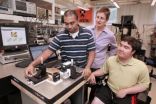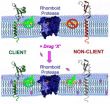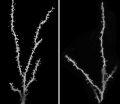(Press-News.org) Princeton University researchers have developed a way to use a laser to measure people's blood sugar, and, with more work to shrink the laser system to a portable size, the technique could allow diabetics to check their condition without pricking themselves to draw blood.
"We are working hard to turn engineering solutions into useful tools for people to use in their daily lives," said Claire Gmachl, the Eugene Higgins Professor of Electrical Engineering and the project's senior researcher. "With this work we hope to improve the lives of many diabetes sufferers who depend on frequent blood glucose monitoring."
In an article published June 23 in the journal Biomedical Optics Express, the researchers describe how they measured blood sugar by directing their specialized laser at a person's palm. The laser passes through the skin cells, without causing damage, and is partially absorbed by the sugar molecules in the patient's body. The researchers use the amount of absorption to measure the level of blood sugar.
Sabbir Liakat, the paper's lead author, said the team was pleasantly surprised at the accuracy of the method. Glucose monitors are required to produce a blood-sugar reading within 20 percent of the patient's actual level; even an early version of the system met that standard. The current version is 84 percent accurate, Liakat said.
"It works now but we are still trying to improve it," said Liakat, a graduate student in electrical engineering.
When the team first started, the laser was an experimental setup that filled up a moderate-sized workbench. It also needed an elaborate cooling system to work. Gmachl said the researchers have solved the cooling problem, so the laser works at room temperature. The next step is to shrink it.
"This summer, we are working to get the system on a mobile platform to take it places such as clinics to get more measurements," Liakat said. "We are looking for a larger dataset of measurements to work with."
The key to the system is the infrared laser's frequency. What our eyes perceive as color is created by light's frequency (the number of light waves that pass a point in a certain time). Red is the lowest frequency of light that humans normally can see, and infrared's frequency is below that level. Current medical devices often use the "near-infrared," which is just beyond what the eye can see. This frequency is not blocked by water, so it can be used in the body, which is largely made up of water. But it does interact with many acids and chemicals in the skin, so it makes it impractical to use for detecting blood sugar.
Mid-infrared light, however, is not as much affected by these other chemicals, so it works well for blood sugar. But mid-infrared light is difficult to harness with standard lasers. It also requires relatively high power and stability to penetrate the skin and scatter off bodily fluid. (The target is not the blood but fluid called dermal interstitial fluid, which has a strong correlation with blood sugar.)
The breakthrough came from the use of a new type of device that is particularly adept at producing mid-infrared frequencies — a quantum cascade laser.
In many lasers, the frequency of the beam depends on the material that makes up the laser — a helium-neon laser, for example, produces a certain frequency band of light. But in a quantum cascade laser, in which electrons pass through a "cascade" of semiconductor layers, the beam can be set to one of a number of different frequencies. The ability to specify the frequency allowed the researchers to produce a laser in the mid-infrared region. Recent improvements in quantum cascade lasers also provided for increased power and stability needed to penetrate the skin.
To conduct their experiment, the researchers used the laser to measure the blood sugar of three healthy people before and after they each ate 20 jellybeans, which raise blood sugar levels. The researchers also checked the measurements with a finger-prick test. They conducted the measurements repeatedly over several weeks.
The researchers said their results indicated that the laser measurements readings produced average errors somewhat larger than the standard blood sugar monitors, but remained within the clinical requirement for accuracy.
"Because the quantum cascade laser can be designed to emit light across a very wide wavelength range, its usability is not just for glucose detection, but could conceivably be used for other medical sensing and monitoring applications," Gmachl said.
INFORMATION:
Besides Liakat and Gmachl, researchers included Kevin Bors, Class of 2013, Laura Xu, Class of 2015, and Callie Woods, Class of 2014, who worked on the project as undergraduate students majoring in electrical engineering; and Jessica Doyle, a teacher at Hunterdon Regional Central High School.
Support for the research was provided in part by the Wendy and Eric Schmidt Foundation, the National Science Foundation, Daylight Solutions Inc., and Opto-Knowledge Systems.
Laser device may end pin pricks, improve quality of life for diabetics
2014-08-21
ELSE PRESS RELEASES FROM THIS DATE:
Objectification in romantic relationships related to sexual pressure and coercion
2014-08-21
To sexually objectify a woman is to focus on her body in terms of how it can provide sexual pleasure rather than viewing her as a complete human being with thoughts and feelings. While objectification has long been considered a problem in the media, how does it affect individual romantic relationships? New research published in Psychology of Women Quarterly, a SAGE journal, finds that more objectification of a female partner's body is related to higher incidents of sexual pressure and coercion.
Researchers Laura R. Ramsey and Tiffany Hoyt surveyed 119 males and 162 females ...
Primary care physicians can be critical resource for abused women in rural areas
2014-08-21
Many primary care physicians in rural communities do not routinely screen women for intimate partner violence (IPV), according to Penn State medical and public health researchers. Rural women who are exposed to such violence have limited resources if they seek help.
"Rural health care providers are uniquely positioned to help women," said Jennifer S. McCall-Hosenfeld, a primary care physician and assistant professor of medicine and public health sciences, Penn State College of Medicine. "However, in rural settings, it might be even more important for physicians to step ...
Viruses take down massive algal blooms, with big implications for climate
2014-08-21
Algae might seem easy to ignore, but they are the ultimate source of all organic matter that marine animals depend upon. Humans are increasingly dependent on algae, too, to suck up climate-warming carbon dioxide from the atmosphere and sink it to the bottom of the ocean. Now, by using a combination of satellite imagery and laboratory experiments, researchers have evidence showing that viruses infecting those algae are driving the life-and-death dynamics of the algae's blooms, even when all else stays essentially the same, and this has important implications for our climate.
According ...
Biologists reprogram skin cells to mimic rare disease
2014-08-21
Johns Hopkins stem cell biologists have found a way to reprogram a patient's skin cells into cells that mimic and display many biological features of a rare genetic disorder called familial dysautonomia. The process requires growing the skin cells in a bath of proteins and chemical additives while turning on a gene to produce neural crest cells, which give rise to several adult cell types. The researchers say their work substantially expedites the creation of neural crest cells from any patient with a neural crest-related disorder, a tool that lets physicians and scientists ...
Sequence of rare kidney cancer reveals unique alterations involving telomerase
2014-08-21
HOUSTON – (Aug. 21, 2014) – An international scientific collaboration led by Baylor College of Medicine has revealed clues about genetic alterations that may contribute to a rare form of kidney cancer, providing new insights not only into this rare cancer but other types as well.
The collaboration, a project of the National Institutes of Health's Cancer Genome Atlas initiative, completed the sequence of chromophobe renal cell carcinoma and published the results today in the journal Cancer Cell.
"The Cancer Genome Atlas is a federally funded national effort that has ...
Some anti-inflammatory drugs affect more than their targets
2014-08-21
Researchers have discovered that three commonly used nonsteroidal anti-inflammatory drugs, or NSAIDs, alter the activity of enzymes within cell membranes. Their finding suggests that, if taken at higher-than-approved doses and/or for long periods of time, these prescription-level NSAIDs and other drugs that affect the membrane may produce wide-ranging and unwanted side effects.
More positively, the researchers say, their work provides the basis for a test that drug developers can use to predict and perhaps avoid these side effects in new medicines they make. A summary ...
Children with autism have extra synapses in brain
2014-08-21
NEW YORK, NY (August 21, 2014) — Children and adolescents with autism have a surplus of synapses in the brain, and this excess is due to a slowdown in a normal brain "pruning" process during development, according to a study by neuroscientists at Columbia University Medical Center (CUMC). Because synapses are the points where neurons connect and communicate with each other, the excessive synapses may have profound effects on how the brain functions. The study was published in the August 21 online issue of the journal Neuron.
A drug that restores normal synaptic pruning ...
Research explains how cellular guardians of the intestine develop
2014-08-21
Even the most careful chosen meal can contain surprises. To defend against infectious microbes, viruses or other potential hazards that find their way to the intestines, a dedicated contingent of immune cells keeps watch within the thin layer of tissue that divides the contents of the gut from the body itself.
New research at Rockefeller University sheds light on the development of a unique class of immune cells known as intraepithelial lymphocytes (IELs) that reside in this critical interface. The findings, published August 21 in Immunity, may help lead to new insights ...
Alternate mechanism of species formation picks up support, thanks to a South American ant
2014-08-21
A newly-discovered species of ant supports a controversial theory of species formation. The ant, only found in a single patch of eucalyptus trees on the São Paulo State University campus in Brazil, branched off from its original species while living in the same colony, something thought rare in current models of evolutionary development.
“Most new species come about in geographic isolation,” said Christian Rabeling, assistant professor of biology at the University of Rochester. “We now have evidence that speciation can take place within a single colony.”
The findings ...
Mouse model for epilepsy, Alzheimer's gives window into the working brain
2014-08-21
(SALT LAKE CITY)—University of Utah scientists have developed a genetically engineered line of mice that is expected to open the door to new research on epilepsy, Alzheimer's and other diseases.
The mice carry a protein marker, which changes in degree of fluorescence in response to different calcium levels. This will allow many cell types, including cells called astrocytes and microglia, to be studied in a new way.
"This is opening up the possibility to decipher how the brain works," said Petr Tvrdik, Ph.D., a research fellow in human genetics and a senior author ...






